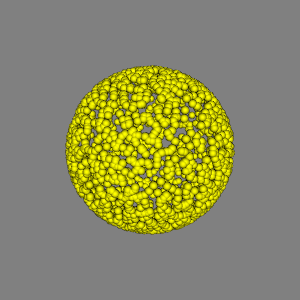FitImplicitFunction
Repository source: FitImplicitFunction
Description¶
vtkFitImplicitFunction object extracts the points that are on the surface of an implicit function (within some threshold).
Implicit functions in VTK are any function of the form f(x,y,z)=c, where values c==0 are considered the surface of the implicit function.
Other languages
See (Cxx), (PythonicAPI)
Question
If you have a question about this example, please use the VTK Discourse Forum
Code¶
FitImplicitFunction.java
import vtk.vtkNativeLibrary;
import vtk.vtkMath;
import vtk.vtkNamedColors;
import vtk.vtkBoundedPointSource;
import vtk.vtkSphere;
import vtk.vtkFitImplicitFunction;
import vtk.vtkSphereSource;
import vtk.vtkGlyph3D;
import vtk.vtkPolyDataMapper;
import vtk.vtkRenderWindow;
import vtk.vtkRenderWindowInteractor;
import vtk.vtkRenderer;
import vtk.vtkActor;
public class FitImplicitFunction
{
// -----------------------------------------------------------------
// Load VTK library and print which library was not properly loaded
static
{
if (!vtkNativeLibrary.LoadAllNativeLibraries())
{
for (vtkNativeLibrary lib : vtkNativeLibrary.values())
{
if (!lib.IsLoaded())
{
System.out.println(lib.GetLibraryName() + " not loaded");
}
}
}
vtkNativeLibrary.DisableOutputWindow(null);
}
// -----------------------------------------------------------------
public static void main(String args[])
{
vtkNamedColors Color = new vtkNamedColors();
//For Renderer Background Color
double glyph3DActorcolor[] = new double[4];
//For Renderer Background Color
double Bgcolor[] = new double[4];
//Change Color Name to Use your own Color for Renderer Background
Color.GetColor("Gray",Bgcolor);
//Change Color Name to Use your own Color for Actor
Color.GetColor("Yellow",glyph3DActorcolor);
vtkMath RS = new vtkMath();
RS.RandomSeed(4355412);
double radius = 1.0;
vtkBoundedPointSource points = new vtkBoundedPointSource();
points.SetNumberOfPoints(1000000);
points.SetBounds(-2.0, 2.0, -2.0, 2.0, -2.0, 2.0);
vtkSphere sphere = new vtkSphere();
sphere.SetRadius(radius);
vtkFitImplicitFunction fit = new vtkFitImplicitFunction();
fit.SetInputConnection(points.GetOutputPort());
fit.SetImplicitFunction(sphere);
fit.SetThreshold(.01);
fit.Update();
System.out.println(fit.GetOutput().GetNumberOfPoints() + " " + "out of" + " " + points.GetNumberOfPoints() + " " + "points are within" + " " + fit.GetThreshold() + " " + "of the implicit function");
vtkSphereSource sphereSource = new vtkSphereSource();
sphereSource.SetRadius(radius * .05);
vtkGlyph3D glyph3D = new vtkGlyph3D();
glyph3D.SetInputConnection(fit.GetOutputPort());
glyph3D.SetSourceConnection(sphereSource.GetOutputPort());
glyph3D.ScalingOff();
glyph3D.Update();
vtkPolyDataMapper glyph3DMapper = new vtkPolyDataMapper();
glyph3DMapper.SetInputConnection(glyph3D.GetOutputPort());
vtkActor glyph3DActor = new vtkActor();
glyph3DActor.SetMapper(glyph3DMapper);
glyph3DActor.GetProperty().SetColor(glyph3DActorcolor);
//Create the renderer, render window and interactor.
vtkRenderer ren = new vtkRenderer();
vtkRenderWindow renWin = new vtkRenderWindow();
renWin.AddRenderer(ren);
vtkRenderWindowInteractor iren = new vtkRenderWindowInteractor();
iren.SetRenderWindow(renWin);
ren.AddActor(glyph3DActor);
ren.ResetCamera();
ren.GetActiveCamera().Azimuth(120);
ren.GetActiveCamera().Elevation(30);
ren.GetActiveCamera().Dolly(1.0);
ren.ResetCameraClippingRange();
ren.SetBackground(Bgcolor);
renWin.SetSize(300,300);
renWin.Render();
iren.Initialize();
iren.Start();
}
}
